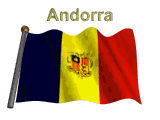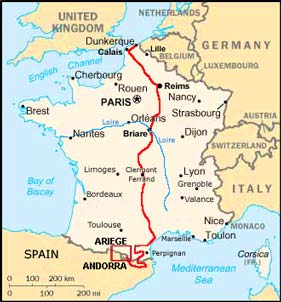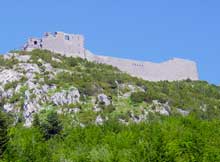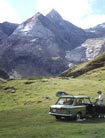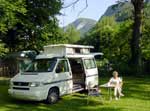|
|
PYRENEES REVISITED - Week 6 News |
||
|
Our 3 day
stay at Vall de Ribes had been the best of the trip and we were sorry to
leave to begin the 50 km drive over the mountains of Collada del Tosa, down
to the French border at Puigcerda. Through the Cerdagne, the high
mountains closed in around us again as we passed through the 4.8 km long
Puymorens Tunnel and emerged into the bleak and rugged landscape at
l'Hospitalet près
l'Andorra, the highest village in the head of the Ariège valley at
1400m. Our route for week 6 was down the glacial valley of the Ariège, starting at l'Hospitalet just below the river's source high in the Cirque de Font Nègre on the Andorran border. The river Ariège gives its name to the Département, one of the most depressed areas of France with low income levels, high unemployment, an ageing population and a long-standing local perception of neglect by the national government. These days, tourism is the main source of income. We moved partway down the upper valley of the Ariège, to the excellent municipal campsite at Mérens-les-Vals planning on walks up in the surrounding hills. But the weather turned stormy with cloud down to valley level. We expended much effort climbing up into the hanging valley of Mourgouillon to the Lac du Comte in search of the black wild Mérenguais horses, a breed reputedly descended from the wild horses of West European pre-history as painted in the Niaux caves. But we saw neither horses nor little else through the lashing mountain rain. Another soaking was the only reward for our efforts. The reason for our next stop near to Tarascon, a small town in the middle Ariège valley, was to visit the prehistoric caves in the vicinity. Our base was the delightful small rural retreat of le Sédour Camping. On opposite sides of the narrow Vicdessos side-valley, there are 2 prehistoric caves open to the public. The smaller Grotte de la Vache had been occupied by communities of Cro-magnon nomadic hunter-gatherers around 12,000 BC. Excavations at the cave encampment had revealed a wealth of flint tools and implements, bone arrow heads and spear points, the bone remains of animals hunted as food, as well as bones with beautiful engravings of animals. These late Palaeolithic peoples were Homo sapiens like ourselves; standing here where our remote ancestors had lived 14,000 years ago inspired a certain feeling of awe. On the opposite side of the valley, leading in from the huge overhang of the cave-entrance, is the Grotte de Niaux. The cave was not lived in, but was clearly regarded by the Magdalenians who occupied the cave of la Vache as some sort of ceremonial sanctuary. 900m into the inner depths of the system, the cave walls are decorated with beautifully preserved outline paintings of bison, ibex, stags and horses. For conservation reasons, photography is not allowed in the cave, but one of the images has been 'loaned' from the Niaux web site (Photo 2) (which is worth visiting www.sesta.fr ) to show these remarkable artistic creations. The following day, we visited the enormous Grotte de Bédeilac cave just up the valley from our campsite; the entrance was so large that during WW II, the Germans had used the cave as an aircraft hangar. In addition to the prehistoric paintings and engravings, the cave was spectacular for the scale of its geological formations. If you are in Ariège, all 3 caves are worth a visit. The small town of Foix is the administrative capital of Ariège. Its twice weekly market is a privilege originally bestowed by the powerful Counts of Foix who ruled the region in the 11~15th centuries. The surviving 3 towers of their power-base castle atop a rocky outcrop still dominate the town. Here were 2 good reasons for going into Foix: to shop for provisions in the market, and to re-visit the impressively preserved Chateau de Foix which had played such a significant part in Pyrenean feudal history. Rather than contend with town traffic on market day however, we caught the SNCF train from Tarascon for the 15 minute journey along the Ariège valley into Foix. The market exceeded all expectations: as usual, we wandered happily among the stalls and were able to shop for charcuterie, confits de canard (much more expensive now than when we first encountered them in the Dordogne in 1995 - remember, N & L?), cheese, veg, home-made marmalade sold by 2 enterprising nuns, and succulent saucisses from M Christophe, le Montagnard (Photo 3). There is simply nothing to rival the sights, sounds, smells and atmosphere of a busy market. From
Tarascon, we detoured eastwards again, almost back to our start-point at
Quillan, in order to visit another castle with 13th century Cathar
associations (see Week 2). This was Montségur,
perched on a 1200m high precipitous Midsummer
Day brought the highest temperatures of the trip, and the threat of more
storms. It was now time for us to be moving westwards, to an even more
remote corner of
Ariège,
the Couserans, known also as "the Empty Quarter" since it is now
so impoverished and depopulated. Follow our travels with next week's
continuing episode of our Pyrenean travels.
|
